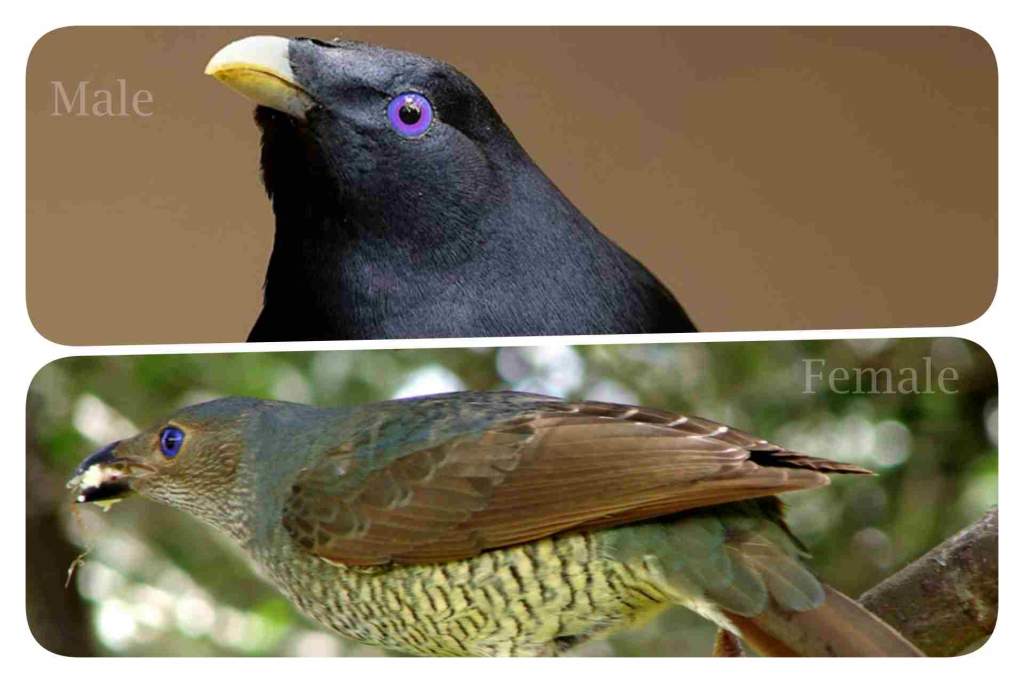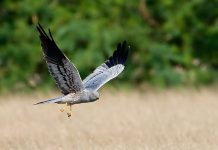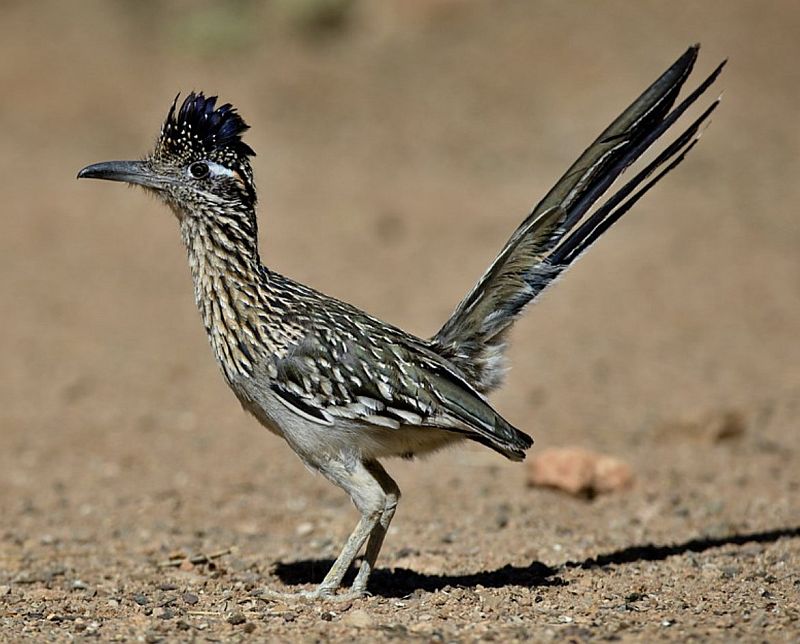Habitat: In autumn and winter, Satin Bowerbirds (Ptilonorhynchus violaceus) leave their breeding quarters on the edges of rainforest and dense wet sclerophyll along the eastern Australian seaboard. They forage in roving flocks. Bands of up to 50 or more move into nearby woodland and fruit groves before raiding for fruit, shoots, and insects picked from tree and bush crowns.
The birds travel silently and furtively, or occasionally hissing softly, flying rapidly but heavily from tree to tree. With spring breeding, they disperse into smaller clans and return to the forests, apparently occupying the same territories year after year. In one clan territory, there may be up to 20 bowers, sub-bowers, and clearings on the forest floor.
Each primary bird is the property of a single male, who tends and protects it throughout the year. He calls from atop the branches, which they rest on only through late summer and autumn. Young males are usually driven off to use communal ‘practice’ sub-bowers. Main bowers are neat avenues of thin sticks woven upright into two walls aligned north-south and usually painted black with charcoal dust and saliva dabbed on the bill. Platforms at both ends are decorated with flowers, feathers, berries, and various man-made objects—mostly blue.
A male displays active behavior only when he is around a female. Whenever one enters the avenue, he prances and bounds stiff-legged in exaggerated postures of begging and aggression. He flares his tail, grabs objects in his bill, flings his wings about, and hisses and churrs, his eyes bulging. Copulation takes place in the bower with any female that visits. Females then leave to build a nest, incubate, and rear young alone, a long distance away.

Identification: The male bird is entirely black with a soft, glossy purple-blue sheen. The eyes glow from lilac to sapphire blue. The bill is short and thick, dull blue with a yellow-green tip. Feet are light green-brown with a yellow tint. The female head and upper parts are a drab gray-green with a faint blue tinge. Wings dull brown to dull green on coverts; inner flight feathers often tipped white; underwing washed buff-yellow; underwing coverts barred.
The tail is dark gray-brown above and yellow below. The underparts are cream to buff-white, strongly dotted with dark olive-grey to dusky grey crescents, giving the throat a spotted appearance and the breast and belly a scalloped appearance. Eyes gleaming lilac-blue. The bill is dark gray-brown. Feet and claws are pale gray-brown.
Immature birds are similar to adult females, but first-year birds are whiter below, with white streaks on the mantle and wing coverts. Older males from the third and fourth years become more uniformly green over the breast and throat, finely marked with white. Full adult male plumage is attained in the sixth or seventh year. Known as Rawnsley’s bowerbird, this rare intergeneric hybrid combines the satin bowerbird with the regent bowerbird (Sericulus chrysocephalus).
Vocalizations: Satin Bowerbird’s contact and alarm call is a harsh, wheezing hiss. Feeding flocks may make continuous croaking sounds, explosive churrings, and whirring rattles, but are often silent in the nonbreeding season. On display, males emit harsh chatterings, buzzing, and creaking churrings, interspersed with loud ringing notes and mimicry of local birds.
Nest and Breed: Nesting and breeding occur in September and January. Nest in a bulky, shallow saucer of twigs and some dry leaves, lined with fine dry leaves, 2-35 m above ground in upright branches of outer foliage, clumps of mistletoe, or against a trunk, well distant from the display bower.
Eggs and Incubation: The bird lays 1 to 3 eggs, usually two; cream to buff-brown, heavily spotted, blotched, and sometimes lined with umber, purple-grey, and ink-grey; oval shape, about 44 x 29 mm. The incubation period is about 21–22 days for females. Young fledge in 19–22 days. After they are fledged, they are taken to a nursery area, where the female tends them for another 8 to 9 weeks.
Distribution: Satin Bowerbird is found in rainforests and the edges of sclerophyll forests on the east coast and adjacent ranges. There are two main populations: one, P.v. violaceus from the Dawes Range and Bunya Mountains, Queensland, south to the Dandenong and Otway Ranges, Victoria, down to sea level. The other, P. v. minor, occurs above 500 m altitude, from Helenvale southwards to the Paluma Range, north of Townsville, Queensland.
Alternative Name: It is also known as the satin bird.
Size: Satin Bowerbird measures 270–330 long, as the male is larger.







